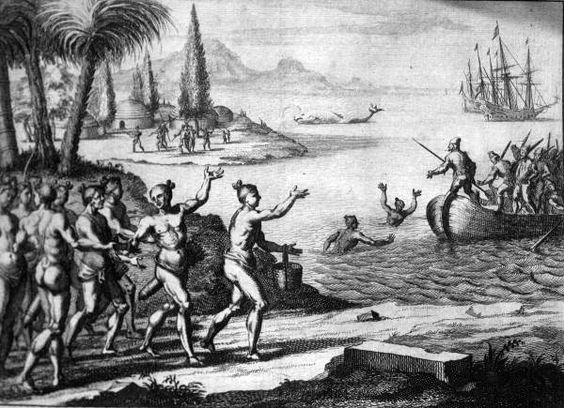Last updated: September 20, 2023
Article
Pedro Bustincuri

FloridaMemory.com
Don Pedro Bustincuri, a page or a cabin boy, shipwrecked in 1546 at the age of 12 and found himself living with the natives. It would be 19 years before he later encountered French and Spanish explorers in 1565. He is one of the earliest reported survivors in the Cape area. It is thought that he was spared due to his young age and taken in to live among the natives. There he learned the language of the Ais.
In 1565 Jean Ribault was commissioned by the Admiral of France to sail a fleet of soldiers to Florida. Rene Laudonniere’s settlement on the St. Johns was in need of supplies and reinforcement. Some of the Laudonniere soldiers resorted to pirating for supplies leaving few soldiers at Fort Caroline. Ribault’s fleet arrived in Florida on August 14, 1565. This was when they first found Bustincuri among the Ais for 19 years and living married to the chief’s sister. The French brought Bustincuri captive with them up to Fort Caroline. All the while Pedro Menendez was racing Jean Ribault to Florida. Spain met with the French and slaughtered them. A small number of Frenchmen including Jaque Ribault the son of Jean Ribault survived the attack by Pedro Menendez and escaped with two Spanish catives one being Bustincuri to France.
The French landed with Bustincuri at Rochelle France on January 6, 1566. Bustincuri escaped the French and made his way to Madrid and was the first to give King Phillip II the news of Menendez’s success in Florida. Bustincuri’s brave and heroic actions earned him title from the king. This news brought reinforcements to Menendez in Florida with which Bustincuri was to venture back across the ocean once again to serve as interpreter for Menendez. He was to serve as a peacekeeper and along with him came gifts for the Ais, with the hope of maintaining friendships. Gifts were brought such as chemise, knives, mirrors, belts and scissors.
The first words said to the natives when landing near shore off the Florida coast were from the interpreter (likely Bustincuri), “The King of Spain has sent us for the Christian men and women you hold captive. You will bring them to us, or you will die. Deliver then and you shall be rewarded.” Menendez at first tried to take notes and speak without the aid of his interpreter. This turned into embarrassment on a few occations. He had mistaken the chief sister as his wife. She was actually a gift for Menendez. Also when the chief was upset about his actual wife’s reaction to Menendez’s compliments Bustincuri stepped in as translator and calmed the situation.
Resources:
- Stetson collections AGI 58-1-32/23. Gov. Manuel de Matiano and royal officials, Juan Lorenzo del Pueyo and Sebastian Sanchez, of Florida to the crown, St. Augustine September 25, 1740, 41ff. Roster is dated Sept. 12, 1740.
-
Canaveral National Seashore Historic Resource Study, Ch.3.
- Pedro Menéndez de Avilés, Captain General of the Ocean Sea, P.54, 1992.Manucy, Albert C.
- Lyon, Eugene. “The Captives of Florida.” The Florida Historical Quarterly, vol. 50, no. 1, 1971, pp. 1–24. JSTOR, www.jstor.org/stable/30140435. Accessed 25 July 2020.
